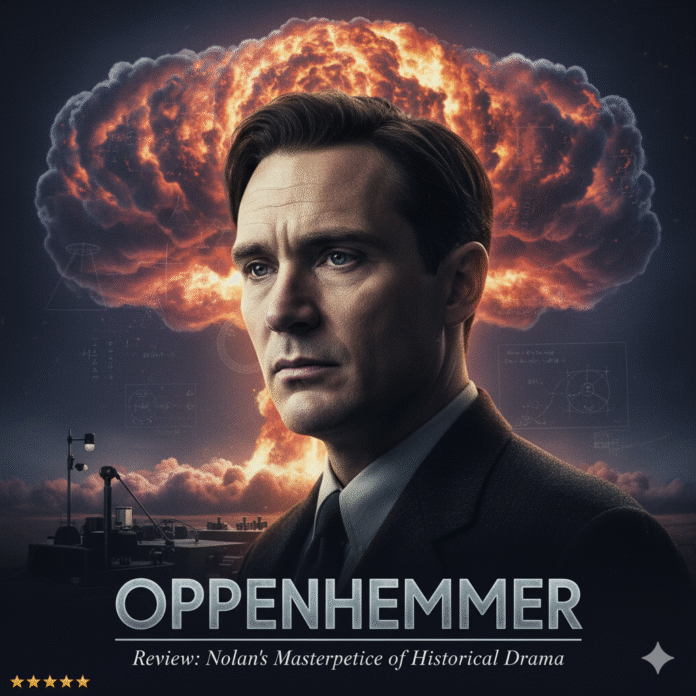Christopher Nolan’s “Oppenheimer” stands as perhaps his most mature and focused work to date, combining his signature non-linear storytelling with a deeply human exploration of one of history’s most morally complex figures. The film succeeds not only as a biographical drama but as a profound meditation on the responsibility that comes with scientific discovery and the weight of choices that shape the world.
Narrative Structure: True to Nolan’s style, “Oppenheimer” employs a complex temporal structure that weaves together three distinct timelines: Oppenheimer’s early career and the Manhattan Project, his 1954 security clearance hearing, and Lewis Strauss’s 1959 Senate confirmation hearing. Rather than feeling gimmicky, this structure serves the story’s themes, showing how past actions reverberate through time and how personal and political motivations intersect in ways that aren’t immediately apparent.
Cillian Murphy’s Transformation: Cillian Murphy delivers a career-defining performance as J. Robert Oppenheimer, capturing both the physicist’s intellectual brilliance and his profound internal conflict. Murphy’s physical transformation is remarkable—he lost significant weight to embody Oppenheimer’s gaunt frame, and his piercing blue eyes convey the intensity of a man grappling with the implications of his work. The performance is both cerebral and deeply emotional, showing Oppenheimer’s evolution from an idealistic scientist to a haunted figure wrestling with the consequences of his creation.
Supporting Ensemble: The supporting cast delivers uniformly excellent performances. Robert Downey Jr. provides a masterful portrayal of Lewis Strauss, bringing complexity to what could have been a simple antagonist role. Emily Blunt as Kitty Oppenheimer brings strength and intelligence to the role of the physicist’s wife, showing how the pressures of their public life affected their marriage. Matt Damon, Florence Pugh, and Josh Hartnett all contribute memorable performances that enrich the film’s exploration of the scientific community during wartime.
Technical Excellence: Hoyte van Hoytema’s cinematography captures both the intimate human moments and the epic scope of the Manhattan Project. The film was shot entirely on IMAX 65mm and 65mm large-format film stock, creating an immersive visual experience that draws viewers into Oppenheimer’s world. The Trinity test sequence is particularly stunning, achieved through practical effects that create a visceral sense of the bomb’s awesome and terrifying power.
Hans Zimmer’s Absence and Ludwig Göransson’s Score: For the first time in many years, Nolan worked without composer Hans Zimmer, instead collaborating with Ludwig Göransson. Göransson’s score is more restrained and classical than Zimmer’s typically bombastic approach, featuring violin solos that represent Oppenheimer’s internal state. The music builds tension without overwhelming the dramatic moments, supporting rather than driving the narrative.
Historical Accuracy and Artistic License: The film draws heavily from Kai Bird and Martin J. Sherwin’s Pulitzer Prize-winning biography “American Prometheus,” maintaining historical accuracy while taking necessary dramatic liberties. Nolan and his team conducted extensive research, consulting with physicists and historians to ensure the scientific elements were portrayed accurately. The film succeeds in making complex physics concepts accessible without dumbing them down.
Thematic Depth: “Oppenheimer” explores themes that resonate strongly in our current technological age: the responsibility of scientists for their discoveries, the intersection of science and politics, and the unintended consequences of innovation. The film doesn’t offer easy answers but rather presents the moral complexity inherent in Oppenheimer’s situation, allowing viewers to grapple with these questions themselves.
Production Design and Costume: Ruth De Jong’s production design authentically recreates the 1940s and 1950s, from the rustic buildings of Los Alamos to the formal hearing rooms of Washington D.C. Ellen Mirojnick’s costume design subtly reflects character development and the passage of time, with Oppenheimer’s clothing becoming more formal and constrained as his public prominence grows.
Cultural Relevance: The film arrives at a time when questions about scientific responsibility, government oversight, and the ethics of powerful technology are more relevant than ever. In an age of artificial intelligence and other potentially transformative technologies, Oppenheimer’s story serves as a cautionary tale about the need for scientists and policymakers to consider the long-term implications of their work.
“Oppenheimer” represents Christopher Nolan at his most restrained and mature, delivering a film that is both intellectually rigorous and emotionally resonant. It’s a movie that demands to be seen on the biggest screen possible while also rewarding careful attention to its intricate narrative structure and complex themes. This is biographical filmmaking at its finest, creating a portrait of a man and an era that feels both historically accurate and urgently contemporary.




